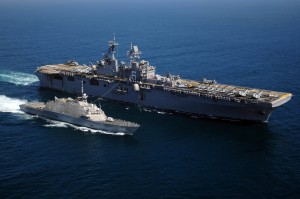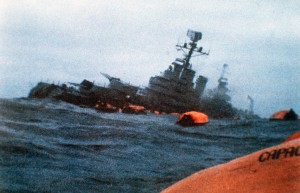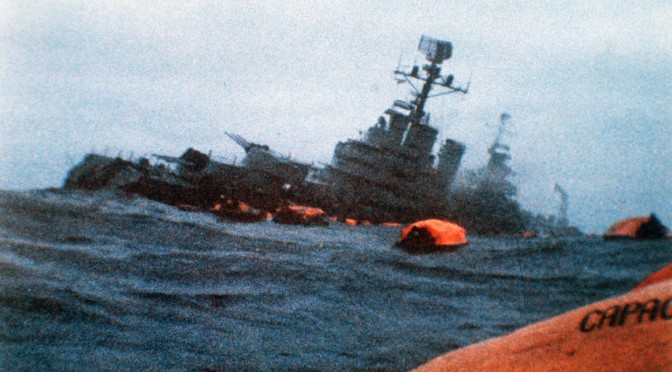“Facts are meaningless. You can use facts to prove anything that’s even remotely true. Facts, schmacts.”
-Homer Simpson, from Lisa the Skeptic
 Both Steven Wills in his USNI Blog opinion piece and Chuck Hill in his response trot out some interesting numbers in support of diametrically opposed positions on the survivability of LCS. According to Wills, the US Navy lost ships under 3400 tons at a much higher rate than larger vessels in WWII. Hill looks at the numbers and comes to the opposite conclusion. The debate reminds me of the recent statistical dustup over the Patriots’ propensity to fumble that has accompanied Deflategate. And the numbers are just about as meaningful.
Both Steven Wills in his USNI Blog opinion piece and Chuck Hill in his response trot out some interesting numbers in support of diametrically opposed positions on the survivability of LCS. According to Wills, the US Navy lost ships under 3400 tons at a much higher rate than larger vessels in WWII. Hill looks at the numbers and comes to the opposite conclusion. The debate reminds me of the recent statistical dustup over the Patriots’ propensity to fumble that has accompanied Deflategate. And the numbers are just about as meaningful.
Wills asserts that the US Navy lost 71 destroyers and 11 destroyer escorts in WWII. Hill makes that number to be 58 destroyers and 9 destroyer escorts. From what I can tell, they’re both wrong. Using the summary report for ship losses to enemy action from 17 October 1941-7 December 1944, the US Navy lost 134 destroyers and 16 destroyer escorts through December 1944. I could not easily find numbers from December 1944 through the war’s end, but the fact that these figures do not include losses from the Battle of Okinawa suggest that the actual number of destroyer losses for the whole war was closer to 150. Over the period of the report, the US Navy also lost 51 cruisers (CA and CL), 22 battleships, and 39 aircraft carriers (combining CV, CVL, and CVE losses).
After citing the number of losses, Hill uses the fate of vessels in commission at the start of the war to extrapolate survivability statistics for all vessels. Statistically, this is highly suspect. As Hill points out, the US fleet at the start of the war included just 233 major surface combatants. But between 1941 and 1945, the US built over 1,300 more major surface combatants, including 349 DD’s and 498 DE’s. Those ships in commission at the start of the war are a non-random sample, since they would tend to be older, slower, and less likely to incorporate new weapons, sensors, and other technologies that could affect survivability, unless backfitted during the war. The US had no DE’s in commission at the start of the war, further skewing the sample.
The numbers in the two reports point out some of the challenges with getting accurate data: since the US had no DE’s in commission at the start of the war, all 16 DE losses should come from those commissioned 1941-1945. But only 9 are annotated as “sunk” in the shipbuilding report. Similarly, 32 of the 349 DD’s commissioned during the war are listed as “sunk,” which when added to Hill’s figure of 29 destroyers in commission at the start of the war that were sunk comes nowhere close to the figure of 134 destroyers lost (nor even to Wills’ figure of 71, although it is over Hill’s figure of 58). But it doesn’t matter.
 The most significant figure in the WWII ship loss data is zero. That’s the number of ships lost to anti-ship cruise missiles. While it’s tempting to try to draw equivalencies between threats in WWII and threats today, the simple fact is that war at sea looks different today than it did then. The Falklands campaign, in which the Royal Navy lost two ships (a 5,000 ton destroyer and a 15,000 ton logistic ship) to Exocet missiles, and another five vessels (one LCU, two Type 21 frigates of 3,290 tons, a destroyer of 5,000 tons, and an auxiliary of 6,000 tons) to aerial bombs, may provide a more relevant frame of reference. British ship losses in the Falkland campaign totaled two of 15 frigates and two of 12 destroyers or larger. While these numbers are helpful, it’s worth remembering the facts behind the data: the RN were limited in their mobility by the need to protect the landing force; the Argentinians were operating at the outer limits of their range, limiting the duration of engagements. And with such a small sample, it’s risky to draw too-strong conclusions.
The most significant figure in the WWII ship loss data is zero. That’s the number of ships lost to anti-ship cruise missiles. While it’s tempting to try to draw equivalencies between threats in WWII and threats today, the simple fact is that war at sea looks different today than it did then. The Falklands campaign, in which the Royal Navy lost two ships (a 5,000 ton destroyer and a 15,000 ton logistic ship) to Exocet missiles, and another five vessels (one LCU, two Type 21 frigates of 3,290 tons, a destroyer of 5,000 tons, and an auxiliary of 6,000 tons) to aerial bombs, may provide a more relevant frame of reference. British ship losses in the Falkland campaign totaled two of 15 frigates and two of 12 destroyers or larger. While these numbers are helpful, it’s worth remembering the facts behind the data: the RN were limited in their mobility by the need to protect the landing force; the Argentinians were operating at the outer limits of their range, limiting the duration of engagements. And with such a small sample, it’s risky to draw too-strong conclusions.
The most significant contributor to ship survivability is not getting hit. Hill argues that LCS will not be a priority target due to its small size and relative unimportance. Such an argument depends on the presence of perceived higher-value targets to draw fire. But the whole nature of the A2/AD problem is that it creates too much risk to put high-value targets under the threat umbrella. If LCS is the only surface platform we’ve got in the fight, it will be the platform that the adversary targets. (Worse, if LCS is heavily dependent on the proximity of vulnerable combat logistics force ships to stay in the fight, an adversary may not need to target LCS at all, choosing instead to sink the oilers, rendering LCS immobile and irrelevant.)
The debate about LCS survivability is important, especially as we look to up-arm the ships and give them more offensive punch. And, given the program’s history of overly-optimistic estimates of cost and capability, I understand why analysts would prefer to “go to the data,” rather than relying on assurances of improved survivability and defensive capability. But unfortunately, we don’t have access to survivability data in an unclassified debate. In the absence of the models and simulations that have been run on LCS versus modern threats, looking for examples from the past of different ship types versus different threats only clouds the picture. In short, going back to World War II data to try to prove a point about the survivability of large ships versus small ships in modern combat is about as relevant as pointing out that USS Constitution, a ship of only 1,500 tons, was so survivable that she earned the name, “Old Ironsides.”
Doyle Hodges is a retired Surface Warfare Officer currently pursuing PhD studies at Princeton’s Woodrow Wilson School of Public and International Affairs.


Uh, the chart you’re looking at (I think) is for ships “damaged or lost,” not just lost. I take that to mean ships that were sunk are counted as are ships that were damaged. My sense of that is confirmed by the fact that the United States had only 26 BBs in commission during all of World War II. The idea that 22 of them got sunk is ridiculous. Similarly, there were only 20 CVs around during the period you’re looking at, so unless some of them got sunk twice…
I’m pretty sure the other two folks are talking about lost as in _sunk_. They’re not wrong, they’re just citing different things.
David’s got it right. Working on a post to lay out the right numbers.
Smaller ships are usually less survivable – I think that’s generally accepted. LCS is probably less survivable than a Level II or III, but also larger FFG (4500T) or DDG (9500T). It is also probably more survivable than an MHC or PC. The issue becomes contentious when we call LCS a frigate replacement and give it more frigate missions. In the case of a mine hit, LCS 2 may be more survivable with its catamaran hull, it is also all aluminum with increased burning and cracking issues. I saw a stupid Navy PR photo of Independance in plane guard for RIMPAC. An un-named flag officer cited it as an example of LCS success. When our leadership is so confused on this ship’s missions, it’s no wonder the rest of us are asking legitimate questions.
For our losses in WWII, is the author using Japanese press figures? For instance, we lost the battleships ARIZONA and OKLAHOMA. What were the other 20?
You may also want to count the kamikazes as manned cruise missiles, and we lost a lot of ships to them in the last year of the war.
@David: Wow! You’re absolutely right. I completely missed the “damaged or” in the title of the chart. That’s a big mistake on my part.
Fortunately, while I was sloppy in reading the chart, that doesn’t affect the primary point of my piece: That WWII ship loss data is not relevant to the LCS debate, since the platforms, technologies, and threats are very different. The WWII data can show that, all other things being equal, large ships are more survivable than small ships, but that’s not the question in the LCS debate. The question in the LCS debate is really, “is LCS survivable enough for the threat it will face?”
Thanks for pointing out my error.
-Doyle
Ok, fair enough. As I told ChuckHill, the WW2 data is relevant in that small ships were lost in greater numbers than their larger cousins. Employment certainly plays a role, but physics are just not in their favor. I agree, the debate is whether LCS is “survivable enough”, given its intended mission and cost. My point was to show that small ships can only be moderately survivable if costs are to remain on the low and the crew of small size side.
Can’t agree with you on relevance. The key technologies in the issue of survivability are still explosives, steel, compartmentation, and anything that keeps the water on the outside of the ship. Bigger ships are inherently more survivable than smaller ships.
So don’t use small ships to do big ship missions. Foreign frigates average over 6000 tons.
The LCS was not designed for for big ship missions. It was designed for minesweeping, sub hunting and chasing pirates/ drug runners. Now the navy wants them to be major combatants. They are adding serious firepower, but no armor. That is like adding a cannon to a Humvee and calling it a tank.
I did not write my response as a defense of the LCS, rather as a response to the contention that WWII data indicated that small ships have no place in the US Navy because they are inherently not survivable. I think I disproved that.
By all means make the small ships as survivable as possible.
My own opinion of the LCS and the SSC is that the extreme high speed requirement was unnecessary and counter productive and that the ships need VLS.
Ok, that’s fair. I do not suggest small ships have no place, but rather that basic physics makes it hard to make them more survivable at a reasonable cost. The WW2 data only suggests more of them were lost than smaller ships.
Budgeting prevails.
Yes, as they always have when money is tight and absent a systemic threat. An example of when they have less influence would be the SSBN programs of the Cold War – money was found to counter the threat with MAD.
I think it would be fair to say that survivability ought to include more than looking at the post hit survivability. It should also include its ability to avoid being hit. LCS advocates point to speed, but I find that unconvincing. On the other hand small size confers some advantages. They are harder to detect. They are harder to discriminate from other contacts. They are easier to hide with soft kill measures. Because they would presumably be more of them, it is more difficult to track them and be sure you have accounted for all of them.
We need more ships. I would never object to steps taken to improve the survivability of ships. Improve compartmentation. Provide redundant propulsion and generator capacity. But taking a position that every ship should be able to take a torpedo hit amidships and continue to fight is unrealistic.
In fact World War II data does not show that larger ships were more prone to survive in the high threat environment that was WWII. It shows the opposite, so people should stop pointing to WWII data as if it were proof of their claim that, ” all other things being equal, large ships are more survivable than small ships,” because that is not what the data shows.
The planners in WWII realized they were going to loose ships, we should also recognize that.
There are so MANY factors which go into survivability no the least of which is destructive aka live fire testing. And I wonder about much of what is said about the AL hull and/or superstructure of LCS. To me, compartmentation of smaller ships is very important. One AMV SME, repteatly states that catamarans are better than either LCS hull form.
And yet… I have heard two well informed individuals state: that since there is an increased threat from missiles of various types, the USN should NOT improve the self-defense weapons on MSC CLF and landing craft. That to me is counter intuitive.
A kamikaze is a cruise missile. Guidance system was Mk 1 shinto pilot type and had issues, but for a pre prototype, was quite effective.